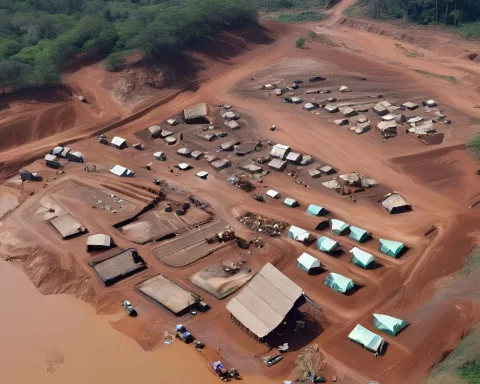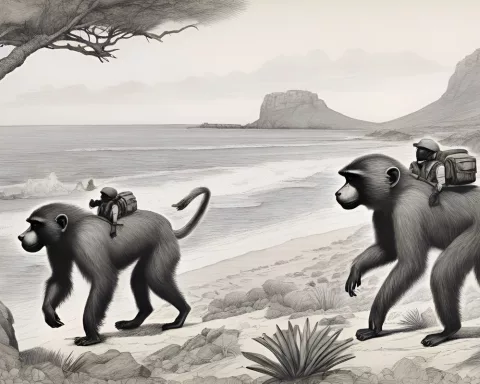The community meetings held by the Cape Peninsula Baboon Management Joint Task Team aim to co-create viable solutions specific to each locality, with community members actively participating in proposing solutions. Attendees will also receive essential information on baboon populations, proposed interventions, and implementation strategies. The initiative reflects a proactive and collaborative approach to sustainable baboon management, striking a balance between human settlement and wildlife conservation.
Proactive Baboon Management Strategy in Cape Peninsula
The Cape Peninsula Baboon Management Joint Task Team (CPBMJTT) is initiating a series of community meetings to address issues presented by baboon encounters in the Southern Peninsula region. These meetings aim to co-create viable solutions specific to the needs and conditions of each locality, with community members actively participating in the dialogue and proposing solutions. Attendees will also receive essential information on baboon populations, proposed interventions, and implementation strategies.
In response to issues presented by baboon encounters in the Southern Peninsula region, the Cape Peninsula Baboon Management Joint Task Team (CPBMJTT) is initiating a series of community meetings. This task force, comprising representatives from SANParks, CapeNature, and the City of Cape Town, is committed to harmonious co-existence with the Chacma baboons indigenous to the Cape Peninsula.
A Collaborative Approach to Baboon Management
The CPBMJTT leverages the Cape Peninsula Baboon Strategic Management Plan (CPBSMP) as a blueprint for sustainable baboon management. This comprehensive plan, uniquely, integrates area-specific solutions co-developed with the communities affected.
The forthcoming community meetings are intended to be a conduit for open and collaborative communication. The objective is more than simply addressing the challenges; it is about co-creating viable solutions specific to the needs and conditions of each locality. These forums offer community members a chance to engage directly with authorities, express their concerns, and contribute their thoughts and solutions.
Utilizing Community Meetings for Information Sharing and Problem Solving
The CPBMJTT plans to use these meetings as a medium to disseminate essential information, offering attendees a clearer understanding of the situation. The educational component includes discussions on the history and patterns of baboon populations in the respective areas, proposed interventions, implementation strategies, and the anticipated transition toward full execution of the CPBSMP.
Residents are strongly encouraged to participate actively in these meetings. They are advised to familiarize themselves with the CPBSMP, as well as the Fencing Report released the previous year. Equipped with this knowledge, they can meaningfully contribute to the dialogue and propose solutions that best address their individual circumstances.
Meeting Schedule and Online Resources
These face-to-face meetings are scheduled to occur from 5pm to 7pm at the following locations:
- Simon’s Town and Murdock Valley: Monday, 10 June 2024, Simon’s Town Civic Centre
- Kommetjie, Imhoff’s Gift, Heron Park, and Ocean View: Tuesday, 11 June 2024, Simon’s Town Civic Centre
- Scarborough and Misty Cliffs: Wednesday, 12 June 2024, Scarborough Community Hall
- Constantia south of Constantia Nek, Tokai, Zwaanswyk: Thursday, 13 June 2024, Wynberg Civic Centre
- Da Gama, Welcome Glen, Glencairn: Tuesday, 18 June 2024, Simon’s Town Civic Centre
- Sunnydale and Capri: Wednesday, 19 June 2024, Fish Hoek Civic Centre
- Constantia north of Constantia Nek: Thursday, 20 June 2024, Wynberg Civic Centre
For those eager to delve deeper into the Cape Peninsula Baboon Strategic Management Plan and the Fencing Report, these documents are available online via the following links:
A Landmark Initiative for Sustainable Baboon Management
These community meetings mark a significant step toward sustainable management of the Cape Peninsula’s Chacma baboons. This initiative reflects the proactive and collaborative approach of the authorities, and the active participation of community members. The combined endeavors of all parties hold the promise of a brighter future for both residents and baboons, striking a balance between human settlement and wildlife conservation.
1. What is the goal of the community meetings held by the Cape Peninsula Baboon Management Joint Task Team?
The community meetings aim to co-create viable solutions specific to each locality, with community members actively participating in proposing solutions. Attendees will also receive essential information on baboon populations, proposed interventions, and implementation strategies.
2. What is the Cape Peninsula Baboon Strategic Management Plan (CPBSMP)?
The CPBSMP is a blueprint for sustainable baboon management, uniquely integrating area-specific solutions co-developed with the communities affected. It is leveraged by the CPBMJTT.
3. What is the objective of the forthcoming community meetings?
The objective is more than addressing the challenges; it is about co-creating viable solutions specific to the needs and conditions of each locality. These forums offer community members a chance to engage directly with authorities, express their concerns, and contribute their thoughts and solutions.
4. What information will be discussed at the community meetings?
The educational component includes discussions on the history and patterns of baboon populations in the respective areas, proposed interventions, implementation strategies, and the anticipated transition toward full execution of the CPBSMP.
5. Where and when will the community meetings be held?
The meetings will be held at various locations from June 10th to June 20th, 2024. The specific locations and dates can be found in the article.
6. Are there any online resources available for further information?
Yes, the Cape Peninsula Baboon Strategic Management Plan and Fencing Report are available online via links provided by SANParks, CapeNature, and the City of Cape Town. These links can be found in the article.












